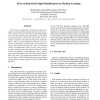Free Online Productivity Tools
i2Speak
i2Symbol
i2OCR
iTex2Img
iWeb2Print
iWeb2Shot
i2Type
iPdf2Split
iPdf2Merge
i2Bopomofo
i2Arabic
i2Style
i2Image
i2PDF
iLatex2Rtf
Sci2ools
ICMLA
2009
2009
Alive on Back-feed Culprit Identification via Machine Learning
We describe an application of machine learning techniques toward the problem of predicting which network protector switch is the cause of an Alive on Back-Feed (ABF) event in the New York City power distribution system. When an electrical feeder is shut down, all network protector switches connected to the feeder should open to isolate the feeder. When a switch malfunctions and does not open, electrical current flows into the feeder, which remains energized. This causes the feeder to be "alive" on back-feed current, and maintenance cannot proceed. Our goal is to provide a ranking of network protector switches according to their susceptibility to such malfunction. Such a ranking can assist prioritization of which switches to repair when an ABF event occurs. We compare three methods for computing a ranking: an SVM classification approach, a maximum entropy density estimation approach and an SVM-ranking approach.
| Added | 19 Feb 2011 |
| Updated | 19 Feb 2011 |
| Type | Journal |
| Year | 2009 |
| Where | ICMLA |
| Authors | Bert C. Huang, Ansaf Salleb-Aouissi, Philip Gross |
Comments (0)

